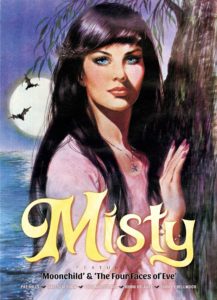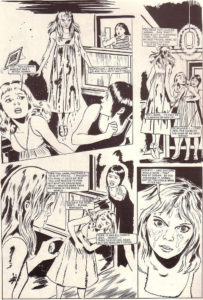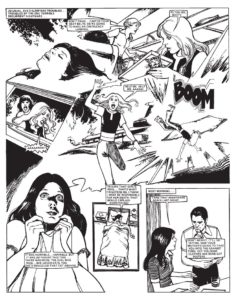Misty, featuring “Moonchild” and “The Four Faces of Eve”
Reviewed by Will Morgan 15-Sep-16
The iconic girls’ horror weekly, Misty, makes a triumphant return from Rebellion! This slender but fully-packed volume of Misty (hopefully the first of many) reprints two of the beautifully-crafted suspense serials which scared the flares off thousand of young girls (and more than a few furtive boys) in the late 1970s.
It was with glad cries that older fans heard of the acquisition of a number of vintage Fleetway/IPC titles by Rebellion, who expressed their intent to revive these classic characters and series.
Among the titles claimed was the vintage girls’ horror/mystery weekly Misty. Our eponymous hostess, a Goth waif with far too much mascara (or “Your Friend of the Mists”, as she introduced herself) presented serials and done-in-one stories of supernatural happenings, entrancing and terrifying thousands of young girls (and more than a few furtive boys) from 1979 to 1981.
“Strange Stories” had long been a staple of girls’ weeklies, but Misty kicked it up more than a notch; the traditional “Strange Story”, as seen in June & School Friend or elsewhere, was plot-driven, with the artwork, while always serviceable and often lovely, taking second place. Misty was visually more open, with larger panels giving the illustrators room to play and load the pages with mood and atmosphere.
Our hostess, too, was a vital presence to the readers; designed and illustrated by Shirley Bellwood, Misty would, in addition to gracing more than half the weekly’s covers, make herself known in elaborate frontispieces or afterwords, tying the whole experience together and making the arrival of each new issue an event.
Then, too, there was the nature of the stories. Not mere “twist ending” fodder, these were often quite shocking for the period, with the usual revenge fantasies – getting one’s own back on a bullying schoolmate or step-parent – frequently fatal, and often out of all proportion to the perceived offence. The stakes were much higher in Misty than in its predecessors, with lives, limbs, or looks (disfigurement was a common theme) under threat – and while the bad girls generally got theirs, being a good girl didn’t necessarily spare you!
This volume gathers two of the fondly-remembered serials in their entirety. Pat Mills’ Moonchild tells of Rosemary Black, abused by her repressive mother and ostracised at school because of her “weird” upbringing, who finds that she possesses eerie powers which emerge when she’s angry or frightened – and with each use, those powers grow stronger and harder to control! Despite the unashamedly Carrie-derivative storyline (Mills’ admitted strategy was to take mainstream hits and modify them for a junior audience), Mills puts plenty of twists into the narrative, and some vivid characterisation, particularly of Rosemary’s mother and the trio of girls at school, led by the truly toxic Norma, who make Rosemary’s life a living hell, until the tables are turned. The horror isn’t all supernatural – Norma and her cohort’s assault on Rosemary and her friend Anne aren’t confined to verbal baiting – physical attacks and psychological campaigning is involved!
Moonchild is illustrated by veteran artist John Armstrong, best remembered for the endless adventures of gymnast Bella over in Tammy, but here delivering excellent moody storytelling. Moonchild was one of the earlier serials in Misty, so Armstrong sticks mostly to the more traditional illustrations, but his mastery of expression is unmatched, and when he does break out, as Rosemary’s powers develop, it’s hard-hitting.
Unfortunately, this version of Moonchild is an edited-together version of the weekly installments, as presented in the 1983 Misty Annual; the editing is occasionally clumsy, and the reproduction less than ideal, with many of Armstrong’s finer lines – and occasionally even the lettering – breaking up. It would have been better to go with the original format, though that would have meant pushing the page count.
The second story, The Four Faces of Eve, avoids that mistake; each four-page installment is produced as it ran, and the energetic and vivid illustrations of Brian Delaney reproduce beautifully. Malcolm Shaw’s script is, frankly, a farrago of nonsense – among other themes, it offers abandonment, vivisection, multiple-personality psychosis, amnesia, murder, conspiracy and clowns – but the mystery is teased along at such a pace that it positively sparkles, with only a somewhat abrupt ending disorienting the reader.
Mills prefaces the stories with his reminiscence of Misty’s origin and concept, and in addition to the usual creator bios, there’s a special page about Shirley Bellwood, the creator of Misty herself.
Hopefully, this will be the first of many Misty volumes, as there’s a substantial amount of quality work languishing; The Sentinels, The Cats of Carey Street, Paint It Black, Hush Hush Sweet Rachel, Nightmare Academy – so much to look forward to!
Tags: Brian delaney, British, Fleetway, girls comics, IPC, John Armstrong, Malcolm Shaw, Misty, Pat Mills, Rebellion, Shirley Bellwood, uk



Hi Will – you say ‘Unfortunately, this version of Moonchild is an edited-together version of the weekly installments, as presented in the 1983 Misty Annual’. I can see that the bottoms of the pages are edited but I don’t think any material has been abridged or skipped over – can you please clarify?
There’s another review on Slings and Arrows: http://theslingsandarrows.com/misty/
Thanks for the link Tony, just checked it. I see that the reviewer on that site has indicated that it does *not* pass the Bechdel test, which is about as wrong as it can get! It only barely passes the reverse Bechdel test – in Four Faces of Eve there are a couple of policemen who talk to each other at various points.
PS now fixed – quick work by Slings & Arrows!